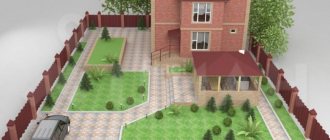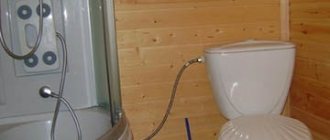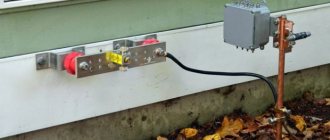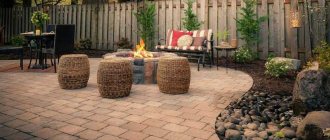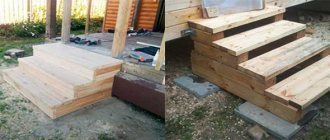The question of how to install a sewer system in a private house is a pressing problem for many country home owners. The comfortable use of a shower, bathroom, washing machine, etc. depends on its proper arrangement.
There are many methods of drainage equipment, the main thing is to be able to choose the right option for your particular case.
Conditions for drainage device
There are several conditions on which the possible version of the sewer system depends:
- time of residence in the house (occasionally or permanently);
- number of people living;
- volume of water consumed per person (cubes per day);
- area of the site (its size determines the possibility of using the territory for organizing a wastewater treatment system);
- groundwater level;
- nature of the soil;
- climate in the area.
Technical standards
So, the sewage system of a private house in the form of a septic tank should be located no closer than fifty meters from the water intake tower. The dimensions of the pit are made 20 centimeters larger on each side compared to the dimensions of the device itself.
The neck of the sewer system of a private house should be located above the ground level; the sides and bottom of the septic tank should be filled with a mixture of sand and soil. Before the final filling, the septic tank must be filled with water.
In addition to the “heart” of this sewer system, we need to make two more important components with our own hands - the wiring throughout the house and the outer pipe, which is buried in the yard. Connections between these three components must be tight and reliable.
Types of sewer systems
There are two categories of systems:
- storage (this includes cesspools, sealed storage tanks);
- treatment plants (this includes septic tanks with one or two chambers, with a filtration field, stations with a biological filter, aeration tanks with a continuous air supply).
Let's consider each sewerage option for the home.
Concrete rings
Sewage systems with storage tanks in the form of concrete rings are also suitable for dachas. The KS brand is used, rings of different sizes. The advantages are obvious: the cost item will be significantly reduced, they are safe, they do not take up much space, they are easy to install and they look aesthetically pleasing.
The disadvantage is the low capacity. But often you have to save water and use it carefully. It is quite possible that concrete rings are the desired, ideal option.
cesspool
It is a well without a constructed bottom. The walls are made from ready-made reinforced concrete rings, lined with bricks, and filled with concrete. The bottom is not equipped, simple soil remains.
Wastewater entering the pit seeps through the soil and is purified. Denser and more solid residues accumulate and will eventually need to be pumped out with a sewer truck.
This variety is suitable only for those who use a small amount of water per day (less than 1 m3). With large volumes, purification does not occur properly, and the effluent can pollute groundwater within a radius of 50 m. If you add microorganisms to the pit, this will reduce the smell and speed up the purification process.
Thus, the cesspool is suitable for houses with non-permanent residence (no more than 2-3 visits per week). It can be done when the groundwater is located at least one meter below the bottom.
Therefore, this method of drainage is not popular in modern suburban housing construction, despite the fact that it is a very cheap solution.
Types of autonomous sewerage
In order to consciously and correctly choose the type of sewage system for your dacha, you need to at least in general terms imagine the advantages and disadvantages of each of the possible options. There are not so many of them:
- Cesspool. The most primitive and far from the best way to dispose of wastewater. Let's start with the fact that it is very difficult to ensure complete tightness. Even with high-quality treatment, some part of the wastewater ends up in the ground. If the source of water is a well or borehole, then sooner or later bacteria will be found in them that live in sewage pits. Other disadvantages are the corresponding smell, which is problematic to combat due to leaks, and the need for regular pumping. Therefore, such sewage systems are being built less and less often in the country.
- Storage capacity. The essence of this type of sewage system is the same: wastewater is collected in containers and periodically pumped out. Only these containers are completely sealed, as they are usually made of plastic. The disadvantage is the relatively high price. Sewage system for a summer residence with a storage tank
- Septic tanks. A system of several interconnected containers (two - three, rarely more). Wastewater enters the first, where it settles and is processed by bacteria. Insoluble residues settle to the bottom, water rises to the top. The next time wastewater arrives, the level rises and the settled water is poured into the next container. Other bacteria “live” here and complete the cleaning (up to 98%). From the second compartment of the septic tank, the liquid can be removed for further filtration into the ground. It's almost clean now. The design is simple, there is nothing to break. The disadvantage is that the device itself is bulky, plus it requires a filtration field (where the water will be discharged), once a year or two the septic tank is cleaned of insoluble sediment.
- VOC or AC - local treatment stations or automatic installations. The principle of operation of a septic tank, but in a more compact size, with electronic filling for control. This type of sewer only works when there is electricity. The maximum battery life is up to 4 hours. The small size of VOCs impose restrictions on one-time discharge of wastewater: if you flush the bathtub, you should not flush the toilet. And the main disadvantage is the price.
Sewage system for a dacha from a two-chamber septic tank
The first two options are simply places for collecting waste; no purification occurs in them. But there is a difference between them, and quite significant. A cesspool is usually made only for an outdoor toilet, but all wastewater is already diverted into a storage tank. That is, this is the most primitive sewage system, albeit without cleaning.
The second two options are already treatment facilities, just with different degrees of automation. As you can see, there is no ideal way. You have to choose between environmental friendliness and cheapness. And here no one can decide except you.
Sealed container
A hole is dug not far from the house, into which a container that does not allow anything to pass through is placed. There are ready-made models made of plastic and metal. You can make it from concrete rings, concrete the bottom and install a metal lid. The main requirement for this type of sewage system is absolute tightness.
Once the volume is exhausted, a pumping procedure will be required. Its frequency will depend on the number of people living in the house and the volume of wastewater.
The advantage of a sealed container is the ability to reduce the risk of soil and groundwater contamination to a minimum. The main disadvantage of actively using the system is the high frequency of work on pumping out wastewater.
By the way, the issue of the location of the container on the site must be resolved at the housing design stage, and in such a way that access for a sewage disposal truck can be ensured.
Safety comes first
How to make a sewer system for a country house? First, a diagram of the pipe wiring inside the room and around the perimeter is drawn up. It must comply with SNiP rules. Pipes are purchased and installation begins. However, this is not where you should start. First of all, you need to select a storage collector.
The basis of the sewage system in a country house is a cesspool. It is periodically cleaned and promptly treated with special substances for the correct, safe processing of organic compounds.
Is it worth making a cesspool for sewage in the country? This option is often chosen, but it has disadvantages. Previously, there was no alternative, and all attention was paid to the quality of its creation. Brickwork filled with concrete - this is how they made a reliable, practical cleaning and storage structure. Now you can do things differently.
Bacteria and household chemicals are the main threat. They can get into the ground if the storage or cleaning tank is not made correctly. Therefore, it is better to carefully study the methods of its creation, familiarize yourself with the latest developments and only then make a decision.
It’s even better to entrust the work to a specialist. When there is a well at your dacha, you can accidentally poison the water in it. Groundwater can also be poisoned. A service such as turnkey sewerage is often offered. In newspapers, on the Internet, on city notice boards you can find contact details, find out the price, and clarify other points.
The pipes must be connected tightly, and the cesspool must also be airtight. Is it easy to achieve this effect on your own? Often a sewage system is created in a dacha with your own hands, because only the owners know where and what grows. But specialists can do everything extremely carefully, with minimal losses. You just need to discuss the main points with them in advance.
TV shows are increasingly showing stories about the work of builders and plumbers of private US companies, for example. At any moment, an American may want to build an artificial pond or fountain, say, in his yard. Builders and plumbers will not stain the carpet or damage the tiles by the pool. Sewage on the site should also be easy to install. By entrusting the work to professionals, you can be sure of this.
And a specialist, unfortunately, will not be able to do anything if it is planned to create a classic cesspool, but water supply is also being installed. The load will be large and excessive.
Septic tank with one chamber
It is a well, the bottom of which is filled with crushed stone and sand (15 cm each). Purification by passing through such a filter is carried out by 45-50%.
After some time, sand and crushed stone become covered with silt and need to be replaced. This method is ineffective in a private home, the residents of which constantly operate all life support systems.
What you need to think about in advance when installing sewerage
Design with the layout of pipes for discharging liquid waste through the sewer system must be carried out taking into account the topography of the local area, the layout of the construction site and the scale of the development.
The development of a scheme for laying a future sewer system necessarily includes an analysis of the following points:
- Choosing the type of septic tank and its location;
- Possibility of connecting the main line to treatment facilities;
- How many people will live during the entire period;
- Permanent or seasonal operation;
- Will specialists be involved in arranging and laying out pipes?
- The scope of the allocated budget for this segment of work.
Septic tank with overflow
It is very popular and is represented by two wells, one of them is sealed, the other has a bottom cushion made of layers of crushed stone and sand.
The first well serves as a settling basin, allowing solid waste to settle and greasy waste to float to the surface. The overflow pipe, at a height of about 2/3 of the total, goes to the second well (filtering), and the water that gets there is purified thanks to the pillow.
A sewage disposal truck is called to such a system less frequently – approximately once every six months. Odor reduction is also possible through the release of microorganisms.
A sewer system in the form of two wells with an overflow will be an excellent option for organizing water flow, especially if the site has sandy or sandy loam soil. It should be remembered that after five years the cushion of sand and crushed stone installed in the second well will need to be changed.
How to connect a sewer to a septic tank
Judging by the standards, the sewer pipe will have to be laid at least 7-8 meters to the septic tank. So the trench will be long. It should go with a slope:
- pipe diameter 100-110 mm, slope 20 mm per linear meter;
- 50 mm in diameter - slope 30 mm/m.
Please note that it is not advisable to change the level of inclination in either direction. You can increase it by a maximum of 5-6 mm. Why can't there be more? With a large slope, the water will run off very quickly, and heavy inclusions will move much less. As a result, the water will drain away, but the solid particles will remain in the pipe. You can imagine the consequences.
The second important condition is that the pipe should not freeze. There are two solutions. The first is to bury below the freezing depth, which, taking into account the slope, gives a significant depth. The second is to bury it to about 60-80 cm and insulate it on top.
Diagram of a country sewer system with a septic tank
How deep should you bury the tube?
In reality, the depth to which you will bury the sewer pipe coming from the house depends on the location of the septic tank, or rather, its inlet. The septic tank itself must be arranged so that there is only a lid on the surface of the soil, and the entire “body”, including the neck, is in the ground. Having buried the septic tank (or having decided on its type and model), you will know where the pipe needs to be led, and the required slope is also known. Using these data, you can calculate at what depth you need to exit the house.
This area of work also has its own nuances. So it’s better to dig a trench of the required depth right away. If you have to add soil, it must be compacted very well - not just throw the soil on, tamp it to a high density. This is necessary because simply laid soil will shrink, and the pipe will settle with it. Over time, a plug forms at the site of subsidence. Even if it can be broken through, it will appear there again from time to time.
The pipes must be installed correctly
Insulation
One more point: the laid and hermetically connected pipe is covered with a layer of sand about 15 cm thick (this should be above the pipe), the sand is spilled and lightly compacted. EPS with a thickness of at least 5 cm is laid on the sand; it must extend at a distance of at least 30 cm on both sides of the pipe. The second option for insulating a sewer pipe is the same EPS, but in the form of a shell of a suitable size.
Special insulation for pipes - shell
It is not recommended to use other insulation materials. Mineral wool loses its properties when wet - it simply stops working. Polystyrene foam collapses under pressure. If you are building a full-fledged sewer trench with walls and a lid, then you can do it. But if the sewer pipe is laid in the ground, the foam may become wrinkled. The second point is that mice like to chew it (EPS don’t like it).
Septic tank with filtration field
Made from several connected wells or one container with three parts. Wastewater settles in the first, in the second, bacteria decompose organic residues, and the third part is the filtration fields, a large underground area (about 30 square meters).
If the soil on the site is not sandy, then it is better to make the field artificial using sand and crushed stone. The finally filtered water is directed into wells or through drainage ditches. From an aesthetic point of view, it makes sense to plant the filtration fields with a flower bed.
The downside will be the need to replace the filtration field over time, and this is a considerable amount of work and an unattractive picture on the site.
The system is a constructive solution, but it should only be organized when the groundwater level is below 2.5-3 m. It is also worth keeping in mind that the distance to sources of drinking water and residential buildings from the fields should be at least 30 m.
Stages of arranging a wastewater system
Before installing a sewer system in a private house , you need to draw up a project. It includes a working drawing, which indicates the dimensions of the plot and marks the boundaries of the residential building and adjacent buildings. After this, a septic tank is located, taking into account the rules of the neighborhood.
Sewage installation work includes the following stages:
- Planning the sewer system.
- Installation of a pipeline in the premises of the house with outlet to a single drain.
- Construction of a collection tank for organic waste with a drainage well.
- Laying a central pipe from the house to the tank.
If you plan to install a sealed tank, the last step is eliminated.
Stage No. 1 - drafting
There are several determining factors, the analysis of which allows you to select a suitable sewer system: soil type, topography of a suburban area, volume of water consumption, groundwater level, neighborhood, location of residential and commercial buildings, availability of a well with clean water.
Let's look at each point in more detail.
We take into account the type of soil and relief
Each type of soil has individual characteristics.
What to pay attention to:
- heaving;
- freezing depth;
- humidity;
- degree of moisture absorption.
The type of soil is important for the drainage system. For example, clay does not allow moisture to pass through very well. But black soil, on the contrary, is good. This parameter is taken into account when determining the filter surface area.
The depth of freezing plays an important role when installing a waste pipe from a cottage. To prevent ice blockage, the pipeline is insulated
If the house is located on a plot with a broken profile, i.e. There are large differences in the level of the ground surface, the septic tank is located in a lowland. Failure to follow this rule will result in partially contaminated water leaking to the surface. The result is severe wastewater pollution on the site.
We calculate the volume of water consumption
The volume of water consumption is important when arranging an individual sewerage system.
The volume of water consumption is affected by:
- length of time spent in the house - main residence or summer cottage;
- number of people in the family;
- number of floors of the cottage;
- number of household appliances.
To calculate the exact figure, you can refer to reference books and SNIPs. Consumption standards are indicated there, calculation formulas and coefficients are given.
In order not to remember the mathematics course, use the online calculator presented on our website. Its calculation algorithm complies with all the rules of current regulatory documents.
For a family of 4 people living on a permanent basis, using a latrine, a bathroom, as well as a washing machine and dishwasher, the daily volume of wastewater is 1 m3.
We take into account groundwater and neighbors
Installation of a drainage septic tank is possible only if there is more than 1 m from the bulk filter pad to the water bed. If this distance is less, organic waste will definitely fall into the aquifer.
The solution to this problem lies in the organization of a sealed septic tank. You will have to spend money on pumping out sewage, but there is no other way out.
An alternative to a holding tank is to install a forced filtration system. This complex is equipped with several levels of cleaning. After a full filtration cycle, the water is suitable for technical needs - irrigation, etc.
Also, before digging a hole for containers, you need to decide on its location. SanPiN requirements strictly determine the distances to which the septic tank is removed from houses, utility structures, trees, sources of drinking water, as well as reservoirs.
The diagram does not indicate the neighbor's plot, but according to regulatory documents there must be at least 3 m from the edge of the tank to the neighbor's fence
Compliance with these standards is the responsibility of every homeowner. If you violate neighborhood rules, in addition to the fines that you will definitely receive, you can harm your own health.
Stage No. 2 - installation of internal pipeline
Good water drainage, first of all, depends on the design of the internal pipeline of the cottage. After installing the plumbing fittings, it will need to be connected to a single sewer pipe, through which the wastewater will go to treatment basins.
Pipeline installation
The first step is to decide on the type of pipes. It is better to purchase products made from polyvinyl chloride (PVC), since cast iron and metal options require welding.
For an inexperienced person, the process of electric welding of cast iron pipes can become a “stumbling block” on the path to a positive result. Cast iron is a brittle metal, and sudden cooling of the butt weld will inevitably lead to the appearance of microcracks.
Plastic pipes have many advantages, including:
- small weight;
- ease of installation;
- affordable price;
- large selection of adapters and bends;
- inertness to aggressive environments;
- durability.
Installation starts from the kitchen. The most distant point, usually the place where the kitchen sink is installed, is located above all subsequent ones.
The last to be connected is the toilet (toilet bowl), the waste pipe of which is located closest to the central drain.
Thanks to the large selection of PVC shaped products, installation is very quick. The presence of the seal must be checked at the warehouse before the goods are released.
It is advisable to combine the kitchen and bathroom into one riser. To connect all water discharge points, except the toilet, a pipe with a cross-section of 50 mm is used. For the toilet - 110 mm.
The angle of inclination depends on the diameter of the pipe. For 50 mm, the difference in height of two points 1 meter apart is 30 mm. This value is strictly recorded in the regulatory documentation.
With a smaller difference, the water will stagnate. At a higher value, solid fractions will stick to the walls of the pipe, and due to the increased discharge rate, there is a high probability of failure of the nearest water seal.
A water seal is a natural barrier that prevents sewer air from entering the room. A sink siphon can act as a siphon.
Detailed information about sewerage installation in a private house is presented in this article.
Pipe ventilation arrangement
The sewer exhaust system is designed to balance the negative pressure inside the pipeline. Due to the connection of sewer pipes with the atmosphere, the system is leveled.
The ventilation system is used:
- fan pipe;
- air valve.
The fan hood is a continuation of the central riser. It is installed above the roof ridge at a distance of 30-50 cm. To protect against precipitation, a deflector is attached to the outlet, which further enhances traction.
Installing a fan hood for a private cottage is extremely impractical. Such a system will require insulation of the pipeline, as well as the allocation of a separate ventilation duct in the partitions.
An air valve is ideal. It is easy to install into the pipeline. The device is installed directly indoors. The valve is equipped with a soft rubber membrane that only allows air to pass inward.
For a two-story house, one device is enough. The valve is installed on the second floor.
Diagram of connecting waste water discharge points to the central pipe. The difference in height between the dishwasher and toilet drainage connections determines the overall angle of inclination of the pipeline
Stage No. 3 - installation of a septic tank
If you decide to make a sewerage system in a private house with your own hands, then it is better to install a septic tank made of concrete rings or a ready-made plastic tank.
The volume of the container for collecting and settling organic waste is determined by calculation. Be sure to add an extra cube. The pipe insertion point is located at a distance of 2/3 from the top edge of the septic tank, so it is not filled to the top.
Construction of a septic tank
The first step is to dig three holes for installing containers. To save time and financial costs, it is advisable to combine two settling tanks into one.
The bottom of the dug hole should be reinforced with a concrete base. Concrete cannot be placed on the ground, so add a layer of crushed stone 20 cm thick.
To construct the base, formwork from construction boards is installed. It must be secured with reinforcement along the outer and inner perimeter.
Use the same mixture composition as for pouring the foundation. In this case, be sure to lay a knitted mesh as a reinforcing element. It is better to take M500 grade cement, since the weight of the filled container will be large.
After the base has hardened, and this will not happen earlier than after 3 weeks, proceed to installing the drives.
Using a crane, concrete rings are installed into the dug hole. When the first link is laid, the joint with the base must be coated with cement mortar or tile adhesive. This way you will achieve tightness.
When installing a septic tank made of concrete rings, it is necessary to apply the solution in excess so that it is squeezed out when laying the next ring
Do the same with subsequent rings. Before installing the second and third, first apply a layer of mortar to the joints. After installing all the links, re-process the joints inside the container. When the tank is installed, a brick partition is made inside.
Inspection hatches are installed for cleaning. The horizontal partition is made of a concrete slab with holes for plastic covers.
The last step is to treat all internal surfaces of the two containers with a waterproofing compound.
It is worth keeping in mind that the outlet from the first container should be 10 cm lower than the first - the entrance from the house.
The angle of inclination is determined by the same parameters as for home wiring: with a pipe diameter of 110 mm, the height difference per 1 m is 20 mm.
Installation diagram of a drainage septic tank with two sealed tanks. The presence of a second container allows you to filter water from silt and other contaminants
To ensure that the slope of the pipe complies with the standards, the inlet of the second settling tank is lowered by 10 cm relative to the first.
Insulation is attached to the top of the tanks, as well as to the inside of the cleaning hatches. Cleanout or inspection hatches are installed directly above the overflow pipes so that they can be cleaned.
To install a drainage well, a concrete base is not required. Here the soil under the rings should allow water to pass through and retain sewage.
Therefore, a sand-crushed stone cushion is poured onto the bottom of the pit. The thicker the layer of crushed stone, the longer the well will perform its functions. After 5 years, you will have to replace the top layer of crushed stone with a new one, because the old one will silt up.
Keep an eye on the level. When installing the first ring on crushed stone, one edge may become warped. If this happens, simply lift the link with a crane and level the level with crushed stone.
The joints of the rings must be treated with a solution to achieve a tight seal. The construction of waterproofing and an inspection hatch is similar to a sump.
This is how a drainage well is constructed. The thicker the bulk filter pad made of crushed stone, the less often it will have to be changed
Organization of septic tank ventilation
Installation of ventilation pipes for septic tanks is justified only if aerobic bacteria are used. They intensively absorb air supplied through the hood.
Another type of biological bacteria are anaerobes. Their life processes take place without oxygen.
It is important not to confuse these two concepts, since some anaerobes die if there is air in the environment.
Aerobes and anaerobes are added to settling tanks. Bacteria completely convert organic matter into water. In practice, this effect can only be achieved by installing complex filtration systems, but they still need to be used. Therefore, install a ventilation pipe in both sumps.
PVC sewer pipe for outdoor use is discharged from each container through a lid. A deflector is installed at the end.
Stage No. 4 - laying the central pipe
The sewer pipe, which removes sewage from the house, is diverted from the base to a distance of 5 m. The pipeline for external use is painted orange. This product differs from “home” pipes in having thicker walls. The permissible laying depth is 3 m.
The depth of the trench is determined according to the table of soil freezing indicators, plus 10%. The average value for Russia is 1.8 m
A layer of sand of 8-10 cm is poured onto the bottom of the dug hole, as well as on top of the laid pipe. To ensure the best removal of organic waste from the house to the septic tank tanks, the pipe should run in one line. Turns of the central drain are strictly prohibited.
Septic tank with biological filtration
A container divided into 3-4 chambers, in which the following stages take place in turn: settling of water, decomposition of residues due to microorganisms, separation of water, decomposition of organic matter due to the constant supply of air.
A disadvantage may be the need for year-round living in the house, since without continuous use the bacteria die, and new ones begin to actively work only after two weeks.
Routing the interior
The installation of a sewer system usually begins with the installation of an internal pipeline. For this purpose, the most suitable type of pipes should be selected.
Today, almost all owners and craftsmen give preference to PVC pipes, which can withstand prolonged contact with moisture and have sufficient strength combined with the elasticity of the material.
The arrangement process includes the following stages:
- Installation of drain points from the most distant rooms.
- The largest number of moisture removal points are located in the kitchen, bathroom and toilet. In this case, the kitchen sink is connected first, and the bathroom last. This fact is connected with the close location of the toilet to the central drain.
- The pipe cross-section for all rooms is 5 cm. The only exception is the bathroom, for which a pipe with a cross-section of 11 cm is chosen.
A smaller diameter will be ineffective, since solid particles will remain on the walls, and water will stagnate on the “elbows” of the pipeline.
Septic tank with aeration
This option is represented by three cameras connected to each other. The first gives settled water and solid sediment. By pumping, part of the water enters the second chamber, where it mixes with sludge (plants and microorganisms).
An air supply (aeration unit) is connected to this chamber. The third chamber serves for deeper cleaning. The sludge from here is redirected to the second chamber thanks to a pump. The disadvantage of the system is the high price, the need for permanent residence and electricity supply.
The correct selection of a sewerage system is a responsible matter that is best entrusted to specialists. They can do all the work or give detailed instructions for installing sewerage in a private home.
Recommendations from the pros
The construction of a prefabricated pipeline with your own hands begins with drilling a 30x30 centimeter square hole in the foundation. Its size is made larger than the diameter of the outlet pipe in order to prevent its damage in the event of shrinkage of the foundation.
When the internal part is mounted, plastic pipes are used, the connection of which is made using fittings. This design ensures the proper level of tightness and other performance characteristics.
- Chicken feeder
Capers - what are they? How to choose, cook and tips on which dishes to use (110 photos and videos)
- Order shaft production
The outer part of the sewer system of a private house to the septic tank consists of one or more pipes. The material for the construction of this system can be cast iron, plastic or asbestos-cement pipes.
Photo of sewerage in a private house
Types of receiving tanks
The practical application of automated equipment and other system elements is based on special containers that collect waste.
The most common options are:
- Reception collectors, cesspools or storage wells. These are densely arranged containers. If they are completely filled with waste, they need to be pumped out using special pumps or using the services of vacuum cleaners.
- Septic tanks are more advanced tanks with the addition of a wastewater purification system. Series-connected modules with step-by-step filtering in each of them. The result of purification is water, which can be safely released into the soil or used for technical purposes.
- Advanced cleansing stations. Here special filter blocks with beneficial microorganisms are used. The passage of the entire treatment system disinfects the wastewater, separating it into water and organic fertilizers.
Setting up a cesspool is the simplest and most inexpensive way without special manufacturing costs, but it has to be pumped out quite often. Septic tanks and deep treatment stations are very expensive, but in the long term they are much more profitable with their rare maintenance and complete wastewater treatment.
Features of choice
When arranging a sewer system for a home, the availability and ability to connect to the central sewer line is not the least important. Connecting to such a structure will be the fastest and easiest option. If it is not available, you will need to install an autonomous system.
The most accessible is the cesspool. The period of operation before the first maintenance is from 1 to 3 years. A more expensive but effective septic tank will last 3-4 times longer. A properly equipped biorefinery station does not require maintenance after launch for several decades, but at the same time its costs are the highest.
Recommendation! One of the most important factors in arranging a domestic sewage system is the correct calculation of the tank’s capacity. The value is calculated based on the maximum possible discharges from all receivers. For example, if 5 people live in a house, each of whom uses 70 liters of water per day, then the total collection will be 350 liters. However, it is recommended to always make the volume of the septic tank receiving chamber at least 1 m3.
Gravity sewerage for a summer residence
Most often, autonomous sewer systems use the gravity principle. The operation of gravity sewerage directly depends on the slope of the pipelines, which was performed at the installation stage of the system. The presence of a slope ensures that the drains move under their own power, using gravitational force. The degree of slope is affected primarily by the diameters of the sewer pipes.
On a note! Too small a slope will lead to waste starting to clog the pipe - and this can lead to a breakthrough, which will be very difficult to eliminate. It is also not worth making a large slope: the wastewater will move too quickly, which will have a bad effect on the quality of self-cleaning of the pipeline, and the waste storage facility will have to be installed deep underground.
Sewerage with natural waste transportation has many advantages.
The main advantages of this design:
- ease of operation and installation;
- low cost of arrangement;
- independence from electricity.
The disadvantage of gravity sewerage is that it cannot function if the sump tank is located at a great distance from the building.
Briefly about the main thing
Sewerage is a pipeline system for collecting and delivering wastewater to a disposal site. According to its intended purpose, it can be domestic, industrial, drainage and storm water. Structurally, it is divided into internal and external. Based on the type of drainage scheme, it is classified into general, separate and semi-separate.
There are the following options for arranging domestic sewerage:
- Drain pit.
- Dry toilet.
- Septic tank.
- Cleaning station.
Each of them has its own pros, cons and application features. Most often, an autonomous system is installed in your home, which in turn is divided into types such as gravity, pressure, cesspool without cleaning, septic tank, storm drain and drainage. When creating a sewer system, it is necessary to take into account the possibility of connecting to a central sewer system, and in its absence, use the most suitable autonomous option.
Ratings 0
Features of the location of external sewerage structures on the site
Sewage scheme
There are several rules and recommendations for placing wastewater facilities on the site.
If possible, the pit for the well is located in the lowest possible place so that the wastewater has the opportunity to flow down at a natural slope. You shouldn’t place it close to anyone, but it’s also not advisable to move it too far away. The optimal distance is from 3 meters to 8-10 meters.
It is necessary to take into account the interests of neighbors when choosing a location for a pit. The desire to move sewerage facilities away from your home is understandable, but if you do this close to a neighboring house, this may lead to conflicts. Agree with your neighbors on the location of the well.
Garden plantings can also become an object that you need to focus on when choosing an installation location. You should not place the drain in close proximity to fruit and berry plantings.
Quick access to external sewerage elements must be provided. This will make it easier to repair and maintain the system. It will also allow you to quickly make adjustments if desired.
If you decide to connect to a centralized drainage system , then it will be useful for you to find out how this happens.
Features of installation of plastic sewerage
For those who like to work on construction or installation tasks on their own at home, an amazing benefit is that equipping a sewer system from plastic pipes is quite simple when compared with organizing a water supply system or the complex dismantling of a cast iron pipeline.
For gravity systems, simple rules apply:
- A minimum of joints and turns for reliability, elimination of resistance and prevention of potential leaks in the future if the joint is violated;
- The sockets for the vertical riser and horizontal connections must be directed against the flow of wastewater.
- It is not recommended to connect pipes with sliding couplings during repair work. In case of an error during cutting, it is better to replace the entire pipe.
- Cutting and shortening of shaped parts is unacceptable.
- Pipes should be selected according to the number of connected devices and the specific slope. So, 10 or 15 cm pipes are suitable for the riser and the area where it is connected to the septic tank. The plumbing is connected in the internal horizontal distribution to the riser with pipes with a diameter of 10 cm, and for other sections - 4 or 5 cm.
- The horizontal layout of sewer pipes must be planned with a slope towards the riser, because the design is without pressure. In this way, it is possible to maintain the required speed of turbulent flow in the flow and avoid silting of pipes.
Pipe laying diagrams
Pipes are laid in three ways:
- Open pipe laying or on top of walls.
- The condition of the pipeline is in sight and, if necessary, there is free access to it.
- Hidden pipe routing or installation inside walls.
- Plumbing fixtures are connected through exposed fittings.
- Communications are not laid in a load-bearing wall, since it is prohibited to ditch it.
Step-by-step hidden scheme:
- In the bathroom, all the pipes are placed in the casing.
- Channels are prepared on the floor and in the walls.
- Pipes are installed in recesses.
- The surface is leveled and covered.
The combination involves laying it over the walls and then hiding the pipeline in a box. Water supply and sewerage pipes should be as close as possible.
Calculation of pipe burial depth
The main criterion for this indicator is the location of the septic tank. Traditionally, tanks are immersed in the ground so that only the lid is on the surface. After installing the septic tank, the location of the pipe from the extreme points and the required slope are determined.
Practice has shown that the depth of the trench must exactly correspond to the calculations. When extracting more soil than necessary, the returned excess must be compacted well. Otherwise, traffic jams will periodically appear in the sagging pipe, reducing the convenience of using the sewer system.
